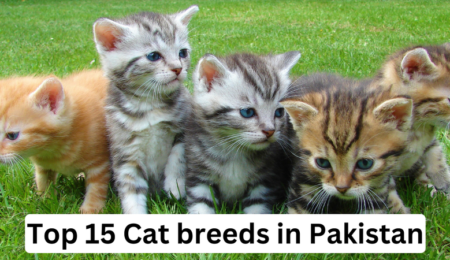➜ How to identify Persian Cat
It is general knowledge that white Persian cats are referred to as long-haired cats due to the thick and silky coat that they possess. People admire them for a variety of reasons, including the fact that they have long hair and a small nose, which is only one of those reasons. The information that suggests Persian cats were transported to the United States around the year 1620 is not only unreliable but also irrelevant to the breed’s knowledge. In the 1800s, Persian long-haired cats made their way to Pakistan from Iran and Afghanistan, as stated by sources that are more trustworthy. This breed was first identified in Pakistan during the nineteenth century by the astute Awan, who was the one who brought it to the attention of the authorities.
The Pakistanis were successful in their endeavor to create a cat with a round face and a flat face so that they could breed a Persian cat. The cat with the flat face, on the other hand, started having some health problems. Due to this particular reason, white Persian cats have always been regarded as the fourth most popular breed of Persian cat by the general public.
Persian Cat Breed Overview ▲
😺 PERSONALITY: Sweet and affectionate; calm and laid-back, Gentle and quiet; social and Friendly.
😺 WEIGHT: Between 7 to 12 pounds (3.2 to 5.4 kilograms).
😺 LENGTH: from 14 to 17 inches (35 to 43 centimeters).
😺 COAT LENGTH: Long and dense, clean and comfortable.
😺 COAT COLORS: Chocolate, Lavender, Silver, Golden, Shaded cameo & More.
😺 COAT PATTERNS: Classic Tabby, Mackerel Tabby, Spotted Tabby, grayish-blue.
😺 EYE COLOR: Copper, Blue, Green, Blue-Green, Hazel Eyes, Odd-Eyed, Golden-Orange.
😺 LIFESPAN: 15 to 20 years, sometimes up to 20 years or more.
😺 HYPOALLERGENIC: Persian cats are NOT considered hypoallergenic.
😺 ORIGIN: Ancient Persia, which is modern-day Iran.
.myButton {
box-shadow:inset 0px 1px 0px 0px #cf866c;
background:linear-gradient(to bottom, #d0451b 5%, #bc3315 100%);
background-color:#d0451b;
border-radius:3px;
border:1px solid #942911;
display:inline-block;
cursor:pointer;
color:#ffffff;
font-family:Arial;
font-size:13px;
padding:6px 24px;
text-decoration:none;
text-shadow:0px 1px 0px #854629;
}
.myButton:hover {
background:linear-gradient(to bottom, #bc3315 5%, #d0451b 100%);
background-color:#bc3315;
}
.myButton:active {
position:relative;
top:1px;
}
Characteristics of the Persian Cat
Several people have a deep affection for the Persian cat due to the fact that it is both aesthetically pleasing and kind toward young children. Because of its fragile nature and susceptibility to injury from rough handling, this Persian cat should be treated with considerable caution. It is possible that it will grow more understanding and friendly toward you if you show it some sensitive love and care. One of the most surprising characteristics of this cat is that, with the right kind of training, it can get along swimmingly with dogs.
As a result of its fun temperament, it walks at a leisurely speed and is completely safe for children to be around when it is at home. As a result, many people take the decision to keep a Persian cat as a pet very seriously. In addition, if you are concerned that its long hair might be a problem, you can give it a little trim whenever you feel that it is in need of it. It is important to avoid trimming the cat too much, since if you do, it will end up looking dull.
🛑 History and Origins ⬇
The Persian cat has been around for a very long time; in fact, the first documented instance of one may be traced back to the year 1684, prehistoric times. It is believed that their name originates from their ancestral homeland, which is now a part of both Iran and Turkey. The aristocrats and royalty of Europe and Persia favored these cats because of their magnificent long coats, friendly dispositions, and expressive emotions. Both of these characteristics contributed to their popularity.
There are many who assert that Persian cats made their way to Europe during the Great Crusades in the 1300s. On the other hand, there are those who contend that the introduction of Persian cats in Europe occurred in the 17th century at the hands of the Italian explorer Pietro della Valle. It was in the late 1800s when they first arrived in North America, and ever since then, they have developed into a breed that is well regarded in this region. The Persian cat breed has developed over time to have ears that are smaller, eyes that are larger, and heads that are rounder. In accordance with the Persian Cat Breed Standard, which was proposed by the Cat Fanciers’ Association (CFA), Persian cats can be found in a wide variety of colors.
🛑 Physical Characteristics ⬇
When it comes to their coats, Persian cats may be found in a wide variety of colors. Solid, silvery-gold, smokey, shaded, tabby, particolor, bicolor, and Himalayan are some of the varieties that fall into this category. Some animals even have little spots of different colors on their fur, which can range from light grays and silvers to dark browns and blacks. This information may come as a surprise to you because their fur can be any shade whatsoever.
Brushing these felines on a regular basis is necessary in order to preserve their long, silky coats, which are a perfect compliment to their large eyes and flat cheeks. The stocky size and short legs of Persian cats make it less likely for them to leap or climb than other short-haired cats. Instead, Persian cats like playing and chasing, which is a natural behavior for them. Their height ranges from ten to fifteen inches, and their weight ranges from eight to twelve pounds. Their usual lifespan is between twelve and fifteen years.
🛑 Temperament and Personality ⬇
The Persian cat is the quintessential example of a stylish and affectionate companion. They are the ideal companions for people who want to unwind in the company of a pet because of their friendly nature and strong attachment to their owners. Persian cats are known to be friendly cats that get along well with dogs and do not require constant stimulation in order to be pleased. This information may come as a surprise to certain individuals. People who are looking for a feline companion that is both calm and affectionate will find that one of these cats is the perfect companion for them.
🛑 Health Considerations ⬇
The lifespan of a Persian cat is typically between ten and fifteen years on average. However, this is true of all breeds. Progressive retinal atrophy (PRA) and polycystic kidney disease (PKD) are also inherited abnormalities that can create substantial issues. Also, these conditions are diagnosed in dogs. Did you know that white Persian cats can avoid these issues by visiting their veterinarian on a regular basis and taking care of their teeth, eyes, and other areas of their body? They should be spayed or neutered, and you should keep a close check on them at all times, so that you can ensure their safety when they are outside.
🛑 Persian cat age Limit ⬇
The life span of a white Persian cat, like any other White Persian cat, generally ranges from 15 to 20 years.
🛑 Types of Persian cats ⬇
- White Persian cat
- Grey Persian cat
- Orange Persian cat
- Exotic Persian cat
🛑 Care and Maintenance ⬇
Persian cats require a lot of grooming due to their long coats—did you know daily combing with a metal comb helps prevent tangles and hairballs? It’s important to establish a grooming routine early to keep them comfortable and maintain their health. Additionally, providing a suitable diet, including special kibble for their flat faces, and engaging them with toys can ensure they stay healthy and happy indoors.
Note: Regular veterinary care, vaccinations, and preventive measures like deworming are crucial for their well-being.
Living Arrangements ⬇
Taking care of a White Persian cat’s coat requires a lot of work—did you know daily combing and brushing are essential to prevent painful mats from forming in their long hair? While they don’t need much exercise, engaging them with play and providing appropriate scratching areas can help keep them happy and healthy indoors.
Note: Some owners choose professional grooming to manage their coat effectively, including options like belly shaving or a lion trim for easier maintenance.
Training and Socialization ⬇
1- Training Techniques for White Persian Cats
Training Persian cats effectively involves using rewards like treats and praise to encourage good behavior—did you know their sensitive nature means they respond best to gentle handling and short, regular training sessions? It’s important to be patient and consistent in teaching them commands, as they may take longer to learn compared to other breeds.
2- Challenges in Training Persian Cats
Training Persian cats can be challenging due to their independent nature. Did you know they may be stubborn at times and choose when to listen. Changes in their environment can affect their behavior during training? Consistency in commands, rewards, and a patient approach are key to overcoming these challenges and fostering successful training sessions.
10 Fancy Facts About Persian Cats ⬇
Here are 10 easy-to-understand facts about Persian cats:
╰┈➤ Ancient Breed: Persian cats are one of the oldest breeds and originally came from Persia, which is now Iran.
╰┈➤ Distinct Appearance: They have long, silky fur, short faces, and big eyes that give them a unique look.
╰┈➤ Calm and Friendly: Persian cats are known for being relaxed and loving pets, great for families and individuals.
╰┈➤ Grooming Needs: Their long fur requires daily brushing to prevent tangles and mats that can hurt them.
╰┈➤ Color Varieties: Persians come in many colors and patterns, like solid colors, two-tone coats, and striped patterns.
╰┈➤ Health Issues: They are prone to genetic conditions like kidney disease and eye problems.
╰┈➤ Indoor Pets: Persians are best kept indoors to protect their coats and because they enjoy the safety and comfort of home.
╰┈➤ Affectionate Nature: They enjoy attention and usually get along well with other pets.
╰┈➤ Playful but Gentle: While not very active, they like playing with toys and can adapt well to living in apartments.
╰┈➤ Long Lifespan: With good care, Persian cats can live for 10 to 15 years or even longer, making them long-term companions.
Note: It’s not necessary that these are the only facts. There can be more facts. But we have written down the main facts that we have noticed.
Breed Variants of Persian cat ⬇
| Solid | Persian cats with a single solid color throughout their coat, such as white, black, blue, or cream. |
| Bi-Color | Persians with a primary color combined with white, creating distinct patches or patterns. |
| Tabby | Featuring striped, spotted, or marbled patterns in various colors like brown, silver, or blue. |
| Himalayan | Known for their color point coat pattern, with darker points on the ears, face, paws, and tail against a lighter body. |
| Shaded | Persians with a light base coat that gradually darkens toward the tips, creating a subtle shading effect. |
| Smoke | Cats with a solid colored undercoat and deeply tipped guard hairs, giving a smoky appearance. |
| Parti-Color | Persians with patches of multiple colors, including calico (white with orange and black patches) and tortoiseshell (mix of black and orange). |
Special Considerations of Persian cat ⬇
| Grooming | Their long, luxurious coats need daily grooming to prevent mats and tangles. |
| Health | They are prone to certain genetic conditions like polycystic kidney disease (PKD) and eye issues, requiring regular veterinary check-ups. |
| Indoor Living | Persians are best kept indoors to protect their coats and because they are less likely to defend themselves outdoors. |
| Facial Structure | Their flat faces can lead to respiratory and dental issues, necessitating specialized care and attention. |
| Social Needs | They are sociable cats that enjoy human companionship and may need interactive play and mental stimulation. |
| Nutrition | Maintaining a balanced diet is crucial to prevent obesity, especially after spaying or neutering. |
Common Persian Cat Diseases & Conditions
🎀 Polycystic Kidney Disease (PKD): Genetic condition causing fluid-filled cysts to form in the kidneys, leading to kidney failure over time.
🎀 Progressive Retinal Atrophy (PRA): An inherited disease that causes degeneration of the retina, eventually leading to blindness.
🎀 Respiratory Issues: Their flat faces can cause brachycephalic airway syndrome, making breathing difficult and increasing susceptibility to respiratory infections.
🎀 Dental Problems: Their shortened jaws can lead to dental crowding and periodontal disease, requiring regular dental care.
🎀 Eye Conditions: Besides PRA, Persians are prone to other eye problems such as entropion (eyelid rolling inward) and tear duct issues.
🎀 Obesity: Due to their sedentary nature and love of lounging, Persians can easily become overweight without proper diet and exercise.
🎀 Skin Issues: Their dense coat and skin folds can lead to dermatological issues like fungal infections and skin allergies.
Frequently Ask Questions
- Can Persian cats be aggressive?
Persian cats are generally not known for aggression; they are typically calm and gentle.
- My cat is an indoor cat, if I let my cat wander will he come back?
Indoor cats may not have the skills to find their way back if let outside.
- Will my cat run away if I let her outside?
Persian cats may run away if let outside, especially if they are not used to it.
- Do Persian cats get along with other cats?
Persians can get along with other cats if introduced properly and given time to adjust.
- I let my cat outside and he hasn’t come back. What should I do?
If your cat hasn’t returned after going outside, try searching nearby and contacting local shelters or posting flyers.
Related Articles:








Leave a Reply